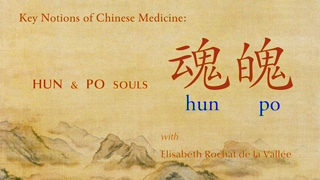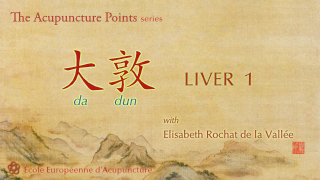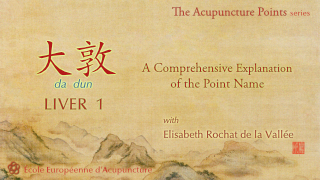Share Elisabeth journey of studying and teaching Chinese medicine, from her early collaborations in Paris with Father Claude Larre and Dr. Jean Schatz to the founding of the European School of Acupuncture on Elevated Practice Podcasts with Dr. Gretchen Badami:
Videos
- without credits
- with credits
This page presents the courses and other teachings available online, some of which come from the "Teaching From the Roots" program. It will be updated as more videos become available.
Online video courses certified for credits (CEU, PDA and others) are listed in the credits section › of this page.
The Way of Water
Four videos totalling 4 hours 10 minutesgo to Vimeo ›
Laozi's Daodejing is one of the most prominent works ever written on how to find enough meaning in the universe for a conduct based on what is beyond this life. Images of water permeate the book with metaphors that show how suppleness and the ability to yield and to endure can overcome force and violence.
more on this course ›
The Book of the Way and its Potency (or Virtue) attributed to Laozi is one of the most important texts of Daoism. It is also one of the most prominent works ever written on how to find enough meaning in the universe to conduct a personal life based on what is behind and beyond this life. It is a text that can be fruitfully studied and meditated even today, and it still inspires the many people's lives.
Images of water permeate the book with metaphors that show how suppleness, apparent weakness, and the ability to yield and to endure can overcome force and violence. 'The strength of weakness' is presented as a way to succeed and to nurture life, for which one must shift internally and adopt another view on human relationships and on how life proceeds. When this change is achieved, 'The Way of Water' reveals its richness and its marvelous efficiency, bringing us close to the source of life.
During the four webinar lectures, this perception will be demonstrated through several selected Daodejing chapters. Several other texts of the same period (the turn of the 3rd century BC) that share the same approach will also be presented.
Handouts provide the Chinese text (with pinyin) for the selected chapters, along with R.G. Henricks’s translation, which is one of the several good available English translations. The participants are of course welcome to use their own favorite translation and eventually question about dissimilarities. All the same, it is not necessary to know Chinese to follow the lectures.

The Seven Emotions in Chinese Medicine
Six videos totalling 6 hours 25 minutesgo to Vimeo ›
A detailed review of the emotions in Chinese Medicine according to the medical Classics; their vision as qi movements, their relation to the heart-mind and all aspects of their normality and pathology.
more … ›
The first video is a general presentation of the emotions in Chinese medicine and thought, and the following five videos present:
Anger - nu 怒
Elation - xi 喜 and joy - le 樂
Obsessive thought - si 思 and worry - lü 慮
Grief - you 憂 and sadness - bei 悲
Fear - kong 恐 and fright - jing 驚

The Eight Extraordinary Meridians
Ten videos totalling 9 hours 51 minutesgo to Vimeo ›
No study of Chinese medicine can be complete without an understanding of the Eight Extraordinary Meridians, which are unique in their primary function as source-spring of regulatory power on blood and qi in the human body.
more on this course ›
In a human, the first manifestation of Heavenly Yang (Dumai or Governor Vessel) and Earthly Yin (Renmai or Conception Vessel), allows a powerful fusion, creating the surge of life (Chongmai); this efferverscence is controlled, as if girdled (Daimai) to enclose a vital space. Two couples come to regulate the yin-yang (blood-and-qi) relationship in an intrasystemic (yin and yang Qiaomai) and intersystemic (yin and yang Weimai) perspective.
This course is an in depth study of each of the Eight Extraordinary Meridians as they appear in the Neijing and the Nanjing, including their development as a unique group of meridians. Each extraordinary meridian will be studied in detail, and its underlying philosophical statement will be explored. The detailed presentation of the major associated Classical texts will deepen and enrich our knowledge.
The course includes: A general presentation, a detailed presentation, the Dumai, the Renmai, the Chongmai, the Daimai, the Qiaomai and the Weimai.

Key Notions of Chinese Medicine

Jing, the Channels (or Meridians) are the norms that structure all forms of circulation in the body and control the flow of qi.
45mngo to Vimeo ›

Mai, the Vital Circulations (also translated as pulses or vessels) are the pathways of blood-and-qi (氣血 qixue)
49mngo to Vimeo ›

Two of the Five Aspects of the Spirit (shen 神), associated with Heaven and the Liver (Hun), and with Earth, the Lung (Po).
88mngo to Vimeo ›

Those two Aspects of Spirit linked with the Spleen and the Kidney are the state, the content and the functioning of the heart/mind.
81mngo to Vimeo ›
Often the most basic concepts of Chinese medicine are the least understood. This study of the key notions of Chinese medicine is an attempt to fill the gap, helping practitioners make the connections between the Classics and their practice.
Each key notion is presented through its character, its uses and meanings in the Chinese classical and medical texts, and with its main correlated notions. Key sentences and excerpts are studied directly from the source texts, including discussion of their practical applications.
Acupuncture Points

The Liver 1 - 大敦 dadun acupuncture point, the first point of the Foot Jueyin Liver meridian.
88mngo to Vimeo ›

Taken from the study of Liver 1, the comprehensive explanation of the point name that helps explain the point's functions, position and roles.
28mngo to Vimeo ›
An in-depth study based on the Chinese Classics, on the deep insight of great masters of the past, and on the knowledge of their cultural environment. These presentations set up a firm foundation for the correct use of the points, which become familiar so as to be easily and naturally used.
The Wei Syndrome
6 videos, 5 hours 48 minutesgo to Vimeo ›
Wilting (limpness, muscular atrophy) pathologies associated with the Wei Syndrome are only fully understood by studying the texts presenting their primary causes. The best is the Suwen chap.44, studied in depth in this course.
more on this course ›
Based on the study of Suwen chapter 44, Jinguiyaolüe and other classical Chinese medicine texts, Elisabeth Rochat de la Vallée presents the main characteristics of Wei, often translated in English by "wilting", "atony", "wasting" or "limpness".
The course videos include:
A general presentation. Analysis of the character wei. What is called wei in pathology. Structure of Suwen chapter 44. The five parts of the body as composing a body of qi, a body in motion.
The effect of the lung internal heat and how it is the first to be responsible for limpness and for a wei symdrome. Lung wei in the Jingui Yaolüe. Beginning of the heat of the heart.
The internal heat in the heart, in the liver, in the spleen and stomach leading to various wei syndromes: wei of the circulation (or vessels), of the muscular movement (or sinews), of the flesh.
The internal heat of the kidneys causing a wei of the bone. Presentation of the primary causes : how emotions produce and internal heat in the lung, the heart and the liver, creating specific wei.
Discussion on zong jin (ancestral muscle, converging of muscular forces) and more on the inner heat of the liver. Dampness harms the spleen, heat harms the kidneys, producing specific wei. Diagnosis according to the five zang organs.
Why the wei pathologies are always treated at the Yangming. More on the zongjin. Relation with Chongmai and Daimai. Treatments at the brook (ying) and transport (shu) points.

Clear and Turbid - qing zhuo 清濁
1 hour 31 minutesgo to Vimeo ›
Clear 清 and turbid 濁 are the two fundamental qualities that initially emerge from undifferentiated primordial matter. They form a yin-yang pair but exist neither in isolation nor as pure terms: they are relative qualities within a process.
more on this course ›
In traditional Chinese cosmology, clear qing 清 and turbid zhuo 濁 are the two fundamental qualities that initially emerge from undifferentiated primordial matter. Light, subtle and inclined to rise, the clear dissipates, expands and moves; its movement is yang and forms Heaven. Heavy, thick and inclined to settle, the turbid stays in place, concentrates and congeals; its movement is yin and forms Earth.
Clear and turbid form a yin–yang pair. Opposite yet complementary, they exist neither in isolation nor as pure terms: they are relative qualities within a process. Nothing can definitively be qualified as exclusively yin or yang, clear or turbid.
In Chinese medicine, the couple of 'clear and turbid' is found in different contexts and at different levels. Understanding what is clear and what is turbid always depends on the context.
For example the thin, light and centrifugal fluids (jin 津) are called clear in comparison to the dense and centripetal fluids (ye 液), even as the ye fluids rich in essences are themselves clear compared to the turbid residue of food.

Ji 幾 - Incipience, the Infinitesimally Small
1 hour 32 minutesgo to Vimeo ›
Ji is the imperceptible beginning, the inner spring of movement that triggers the passage from one state to another. It is the the subtle inception of a movement that has already begun. Hence, its importance for the diagnosis of the great practitioner.
more on this course ›
Ji 幾 is the almost imperceptible beginning that determines the direction to be taken by the course of events. It is the inner spring of movement not yet visible on the outside that triggers the passage from one state to another. It is the the subtle inception of a movement (of the mind and of events) that has already begun. Hence, its importance for the diagnosis of the great practitioner.
Those penetrating incipience see where all phenomena and events come from and foresee their developments; they know the intrinsic causes of change in things.
Ji 幾, incipience, is the passage from the formless, that which is hidden and not yet manifest, to the form, that which has already started to become a specific thing, a phenomenon, an event.
The art of the great practitioner lies in the ability to grasp these passages, to perceive the imperceptible beginning of a disorder, to anticipate its potential development by understanding correctly the smallest signs. Then one is able to make a subtle diagnosis and to treat before the disease has settled in deeply.

Other Videos
Many more videos are available in French; they are presented here ›.
Please go to easterncurrents.ca ›
For the US go to lhasaoms.com ›
For England and Europe go to cpd-cert.com ›
For Germany and Europe go to www.acupunctureworld.com › (or in german: www.acupunctureworld.de ›)
For Australia and New Zealand go to chinabooks.com.au ›
As the leading Chinese Medicine continuing education provider, the TCM Academy aims to inspire worldwide practitioners in their lifelong learning process by providing the best education in this field, supporting professional growth and confidence, and helping you to develop from the comfort of your home or office. We believe in merging old and new, thus offering courses by the world's leading sinologists and practical approaches with clinical protocols from seasoned clinicians from the many Chinese medicine branches.
Link to Elisabeth's page ›




 top
top